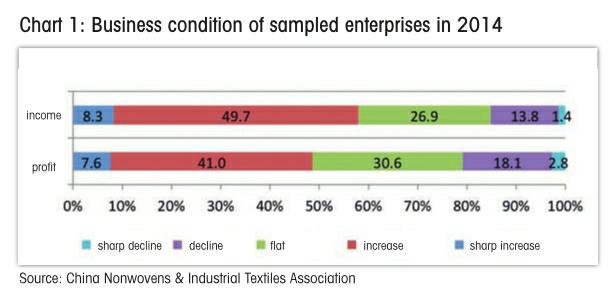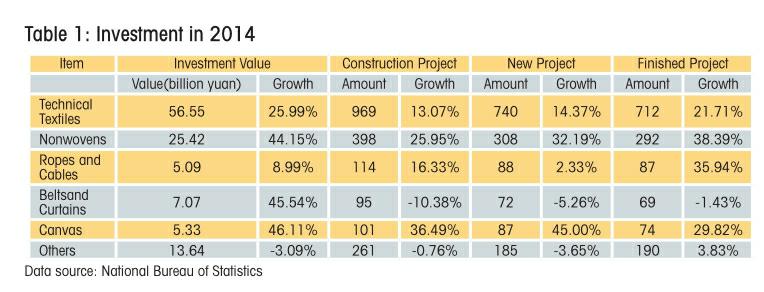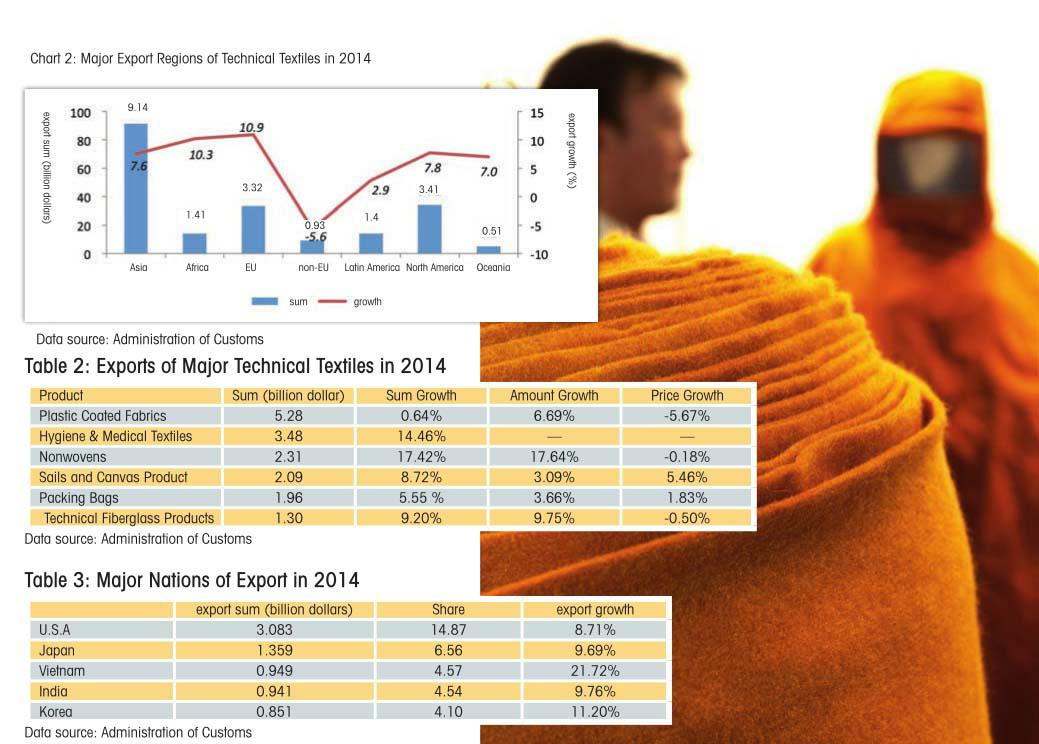Technical textiles:Being stable under the“New Normal”
By+Li+Yili
Booming in economic benefi t
In 2014, economic value added of technical textiles industry enjoyed growth rate of 11.7%, while that of textile industry was 6.7%, and enterprises above designated size was 8.3%.
The 1795 technical textile enterprises above designated size reached main business income of 270.22 billion yuan and total profi t of 15.43 billion yuan, rising by 12.39% and 13.79% respectively, with 5.6 and 7.7 percentage points higher than the textile industry. The average rate of profi t was 5.71%, with slight increase over the previous year and enterprises losses value fell by nearly 50%. In 2014, the industry continued its development to better economic situation.
Enterprises above designated size made production of 3.614 million tons in nonwoven fabrics, in- creasing by 10.73%, higher than the growth in fi rst half year but slightly lower than the same period of the previous year. Growth rate declined, because of the large cardinal number formed by years of rapid growth, as well as the accelerated pace of transformation and upgrading of industry and elimination of backward production capacity. And the nonwovens sales grew by 13.73%, while the total profi t increased by 6.28%, down by 4.6 and 17.8 percentage points respectively compared with the same period of the previous year. The decrease of income and profi t growth were caused by decline in output growth, great pressure on product prices from lower raw material prices, as well as the intensifying competition led by increasing industry capacity. According to the Customs data, nonwovens export price edged down by 0.18%, and due to technological advances and changes in product mix, Chinas nonwovens industry has strengthened its competitiveness in the international market significantly against the background of lower raw material price.
According to investigation of China Nonwovens & Industrial Textiles Association (CNITA), 8.3% of respondents made significant growth in main business income (over 20%), nearly half of the enterprises had more than 10% revenue growth, 26.9% remained the same and there were 15.2% of the enterprises experiencing different degrees of reduction in income. Nearly half of corporation increased their profits, 30.6% held the line and 21% suffered decrease. (Detailed information and analysis refers to Chart 1)
Rapid growth in investment
According to the National Bureau of Statistics, the industry completed investment in fi xed assets of 56.55 billion yuan in 2014 (Table 1), with a year-on-year increase of 25.99%, ranking in front row in textile industry, in spite of the falling of growth rate compared with the previous year. According to CNITA, current investment focused on technological innovation and latest high-capacity, with high sum in independent in- vestment, laying a good foundation for technological progress and competition in international market.
Nonwovens are still the most popular areas of investment, with investment growth of 44.15% and new projects growth of 38.39%, which was rebounded signifi cantly compared with the previous year and will maintain its rapid growth in the future. In addition, the investment in filtration textiles and geotextiles also maintained in high growth.
Steady increase in import and export
In 2014, China exported all technical textiles valued $ 20.74 billion, with an increase of 7.6%. Technical textiles exports experienced negative growth in 2012, which rebounded to 8.36% in 2013, and in 2014 the export continued its stability, yet with a large gap to the growth rate of 26.3% in 2011, which was mainly caused by weak foreign demand as the economic recovery was still poor in developed economies except the US.
Technical plastic coated fabrics, hygiene and medical textiles, nonwovens, sails and canvas products, packing bags, technical fi berglass products ranked the six largest exported products, with total share of 79.2% to all exports (detailed information refers to Table 2). Due to the poor growth of external demand, coupled with the sharp falling of raw material prices, the amount served as the major support to export growth.
From region perspective (Chart 2), Asia was the largest export market for Chinas technical textiles, accounting for 45% of total exports, followed by the EU and North America, whose shares were all around 17%. In these three major markets, export to the EU reached growth of 10.9%, that to North America enjoyed increase of 7.8%, and the Asian market experienced rise of 7.6%, of which exports to ASEAN was close to 10%. African market only shared 7% of Chinas technical textiles exports, yet with considerable growth of 10.3%. And export to non-EU European market suffered decline of 5.6%.
From nation perspective, the United States, Japan, Vietnam, India and South Korea were the first five largest importers of Chinas technical textiles, contributing to 34.6% of Chinas export value. In addition, the growth of export to these major countries have also maintained a high growth rate, especially that to Vietnam, which grew by 21.71%. (Detailed information refers to Table 3)
In 2014, China imported technical textiles of $ 4.38 billion, increasing by 10.89% over the same period of the previous year. The plastic coated fabrics, nonwo- vens, hygiene and medical textiles, technical fi berglass products, fi ltration textiles were the major imports, accounting for 81.07% of the total value.
China Taiwan, Japan, Korea, the United States and Germany were the main exporters for Chinas technical textiles, taking the share of 77.5%, among which 75% of imports from Taiwan were plastic coated fabrics and fiberglass products, and that imported from Japan, the United States and Germany were mainly nonwovens.
In 2015, technical textiles industry will see rapid growth in domestic market and recovery in external demand, so that the industry will still enjoy steadily rapid development, with promotion of technological progress and acceleration of industrial restructuring. The whole year is expected to witness 10% growth in total industrial output value, sales revenue, total profi t and output of main products.

